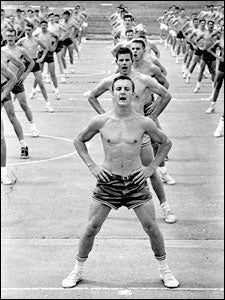BACK IN THE SEVENTIES, when I was in grade school, fitness was quantified on the playground a few times each year when kids tried to earn the Presidential Physical Fitness Award by humiliating themselves in front of their cackling classmates. You may remember the criteria for this torture test: a nine-second shuttle run, a seven-minute mile, 37 push-ups and 47 sit-ups (each within one minute), and eight pull-ups. According to my calculations, approximately 0.01 percent of kids were capable of earning the coveted blue patch with the eagle on it. I wasn’t one of them. I still have nightmares of approaching the chin-up bar, hopping on, and frogging my legs through the air, trying to realize my prayers from the night beforeÔÇöplease, God, just one!
VIDEO KILLED THE JAZZERCISE STAR
By the time this year’s “President’s Challenge” rolled around, the government was begging Americans to do somethingÔÇöanythingÔÇöfor 30 minutes a day, five days a week. I checked out the list of recommended activities. There were a few good ones, including surfing and skiing. Others seemed dubious. Darts? Household tasks? Nintendo Wii? The old fitness tests remained a little-emphasized part of the programÔÇöthere was a Presidential Champion Award, designed for elite athletes. But the government pointed the rest of us toward video games.
The whole thing smacked of desperation. Little wonder, since the Centers for Disease Control recently presented alarming statistics showing that obesity rates had climbed from around 15 percent of the U.S. adult population in 1980 to more than 30 percent by 2006. According to the CDC, other problems linked to excess body weight, such as Type 2 diabetes and coronary heart disease, are on the rise, too. Sure, a select few of us have access to more fitness advantages than ever: futuristic gyms, human-performance labs, supplements (legal or not). But our national waistline is still ballooning.
To see just how far our standards have fallen, I decided to compare the abuse of yore with the user-friendly plan of today. I would go through the 1977 fitness test, spend two weeks doing my 30 minutes of very little a day, then retake the test. On a sunny Saturday I drove to a middle-school field ringed by a dirt track. A rusty soccer goal listed at one end, and prairie dogs had punched holes through the grass. The tableau seemed troublingly representative of fitness in America. But then, so did my test scores: a ten-second shuttle run, a 7:20 mile, 15 push-ups, 46 sit-ups, and two pull-ups. (I was trying, I swear!)
For the next two weeks, I dutifully followed our government’s current plan: 30 minutes of “moderate-intensity” activity (walking my dog; moving boxes) for ten of the 14 days. Then I retook the test: an 11-second shuttle run, a 7:21 mile, 20 push-ups, 42 sit-ups, and one sad, single pull-up. The slippage confirmed my fears: I still had wimpy arms, and the new President’s Challenge wasn’t going to do diddly for me.
Naturally, the folks at the PCPFS don’t see it that way. “We created recognition programs for just moving your body,” says Melissa Johnson, the council’s executive director. “You can do almost anything. It doesn’t have to be drudgery. It can be fun!”
Sure. That’s why Wii Fit sells (see below). Look, it’s hard to criticize something that gets us up and moving, even if it is a video game. Actually, scratch that. Video games should never be called serious exercise tools, no matter how fun they may be. The problem with the 30-minutes-and-done national fitness plan is that it reinforces what exercise has been for way too long in America: a daily task to be crossed off a checklist before we return to our flat-panel, drive-through lives. I’ll be the last person to discourage someone from going for a 30-minute “brisk walk.” But c’mon, people. That should be your warm-up.


